With its vast array of habitats it’s not surprising to find that Louisiana is teeming with wildlife. From tiny insects to the immensely powerful American alligator, with thousands of animals in the state you are sure to come across some where ever you are. Snakes are particularly abundant and there are around 50 different species in the state, including seven that are venomous. A lot of these are brown so you’re probably wondering how to identify them, so let’s discover some of the brown snakes in Louisiana!
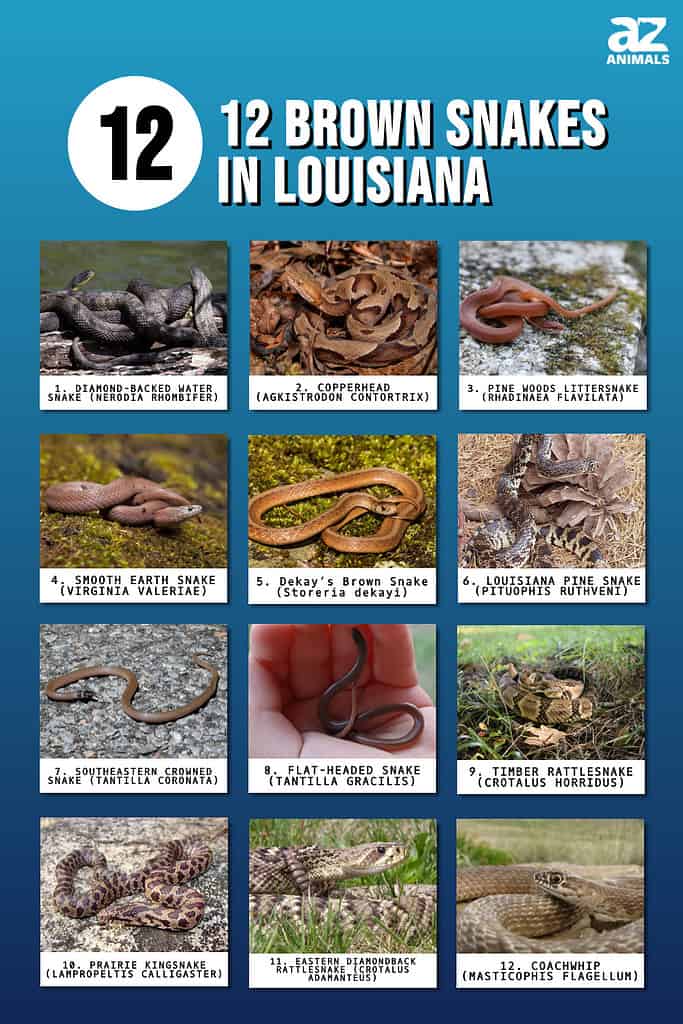
1. Diamond-Backed Water Snake (Nerodia rhombifer)
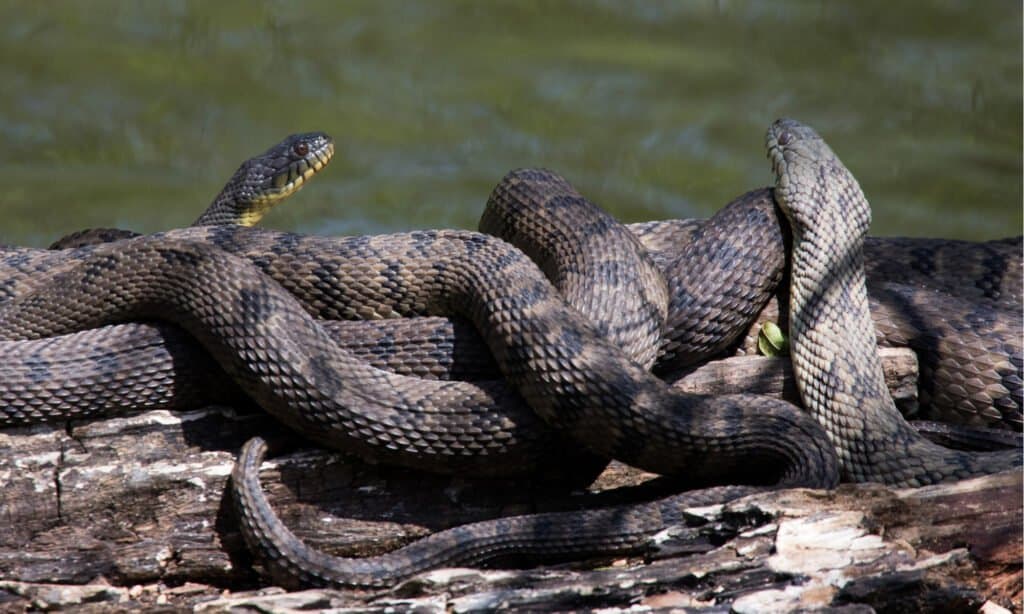
Diamond-backed
water snakes are not venomous
but will hiss and sometimes bite when they are threatened.
©Laurie L. Snidow/Shutterstock.com
The first snake on the list is the diamond-backed water snake which lives statewide in slow-moving bodies of freshwater — such as swamps, streams, and lakes. Diamond-backed water snakes are typically 30 to 48 inches long and have brown bodies. They also have a dark brown chain-like pattern which forms diamond-shaped markings on their back. Diamond-backed water snakes are not venomous but will hiss and sometimes bite when they are threatened. They are sometimes misidentified as other snakes — particularly rattlesnakes or venomous cottonmouths.
2. Copperhead (Agkistrodon contortrix)
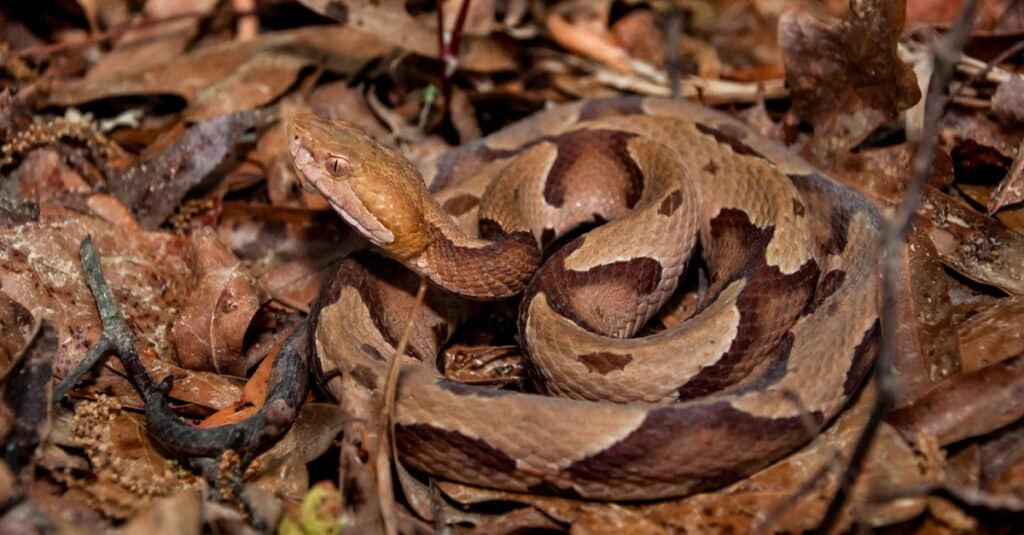
Although they are venomous copperheads have fairly mild venom and are not particularly aggressive.
©Jay Ondreicka/Shutterstock.com
The first venomous brown snake in Louisiana is the copperhead. These snakes are typically 20 to 37 inches long and have a tan to pinkish brown colored body. They also have dark brown hour-glass shaped markings with lighter-colored centres. Copperheads live in woodlands and forests right across the state with the exception of areas where there are a lot of permanent swamps. Although they are venomous copperheads have fairly mild venom and are not particularly aggressive — meaning that bites from them are rarely fatal for healthy adults.
3. Pine Woods Littersnake (Rhadinaea flavilata)
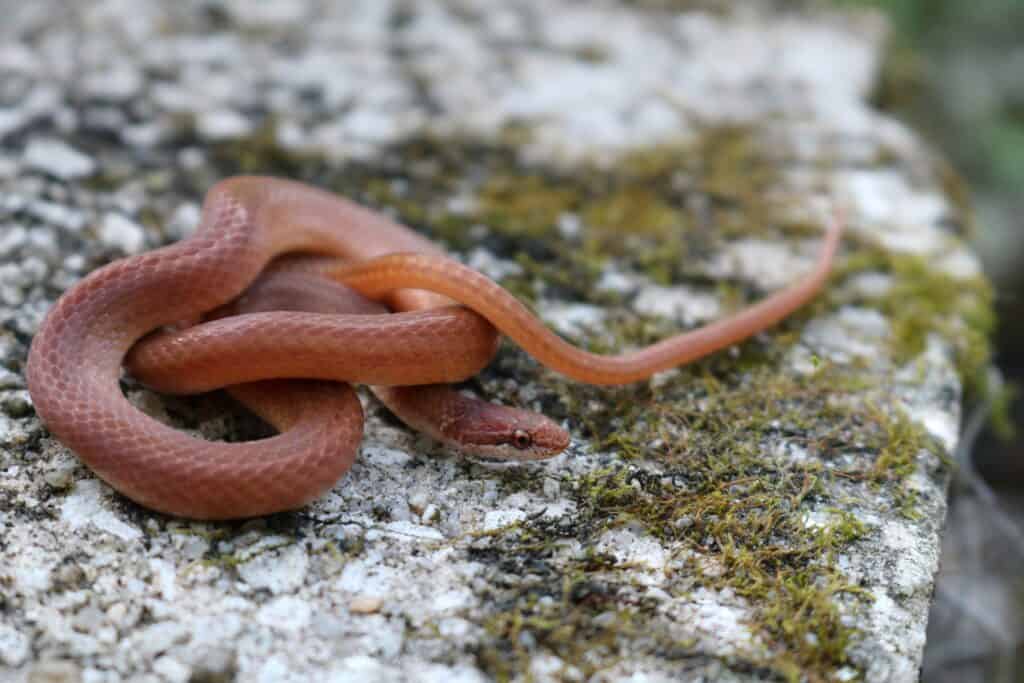
The pine woods littersnake is a critically endangered snake within Louisiana.
©Andrew Jeffries/Shutterstock.com
Next, we have the pine woods littersnake which is a critically endangered snake within Louisiana. Pine woods littersnakes live in pine flatwoods and hardwood forests but only occur in the Florida Parishes of Livingston and St. Tammany. They are small snakes at only eight to 15 inches long and are a reddish brown color on their dorsal side with a lighter colored belly. They also have yellow or white lips which is why they are also known as the yellow-lipped snake. Pine woods littersnakes possess small fangs at the rear of their mouth and are mildly venomous to their prey but are not considered to be dangerous to humans. Instead, they prey on small animals such as frogs, salamanders, lizards, and other small snakes.
4. Smooth Earth Snake (Virginia valeriae)
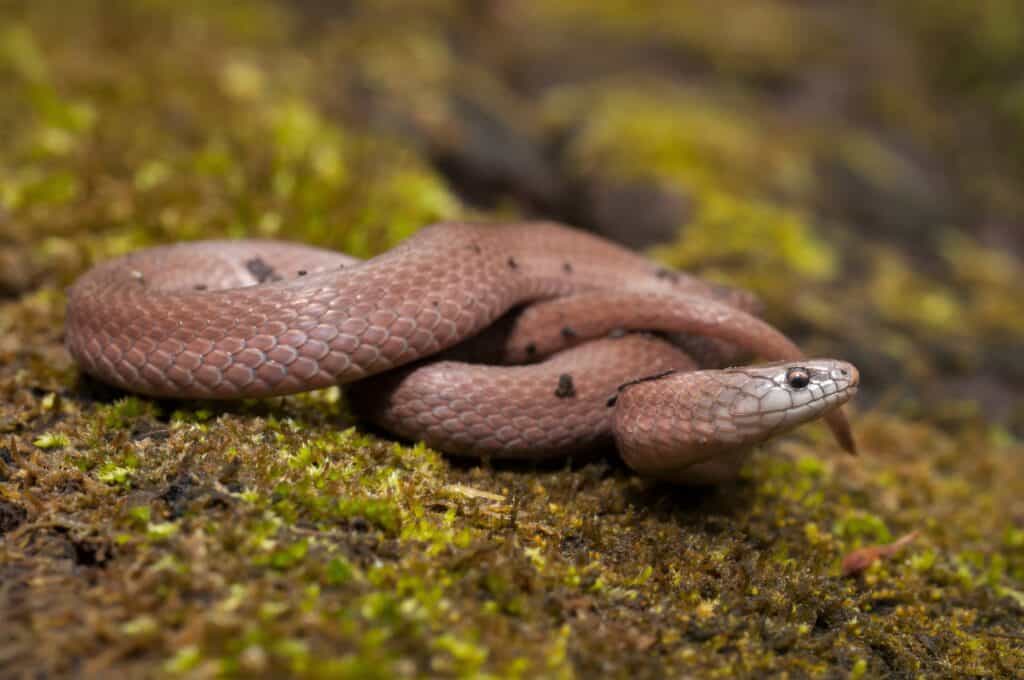
Smooth earth snakes are often mistaken for other small snakes like ring-necked snakes and De Kay’s snakes.
©Mike Wilhelm/Shutterstock.com
One of the smallest snakes in the state is undoubtedly the smooth earth snake which is only seven to 10 inches long. Smooth earth snakes are completely harmless and prey only on earthworms, slugs, and insects. They have reddish brown bodies with small black dots on their head and smooth dorsal scales. Smooth earth snakes live in woodlands and forests where they can bury themselves in the leaf litter. They occur in the Florida Parishes and upland regions of northern and central Louisiana.
5. Dekay’s Brown Snake (Storeria dekayi)
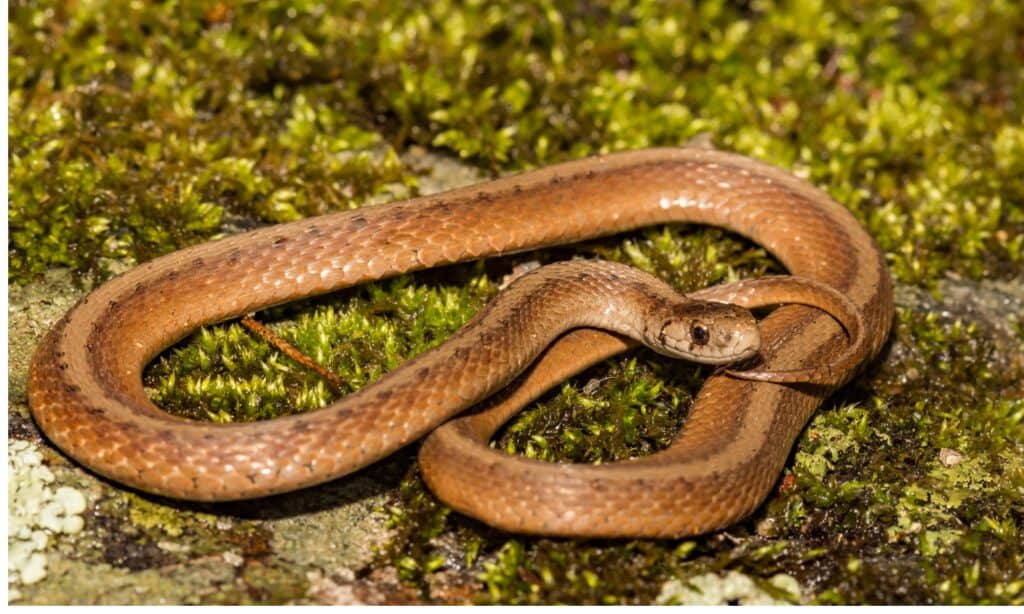
Dekay’s brown snakes are found right across the state and live mainly in wetland and forest areas.
©iStock.com/JasonOndreicka
Another small and harmless brown snake in Louisiana is Dekay’s brown snake which is only nine to 13 inches long. These snakes have light brown bodies with a light stripe down their back and a few black spots on either side of it. Dekay’s brown snakes are found across the state and live mainly in wetland and forest areas. They are shy, nocturnal snakes and prefer to hide away in the leaf litter, meaning they are rarely seen. As they are so small they only prey on small animals such as slugs and earthworms.
6. Louisiana Pine Snake (Pituophis ruthveni)
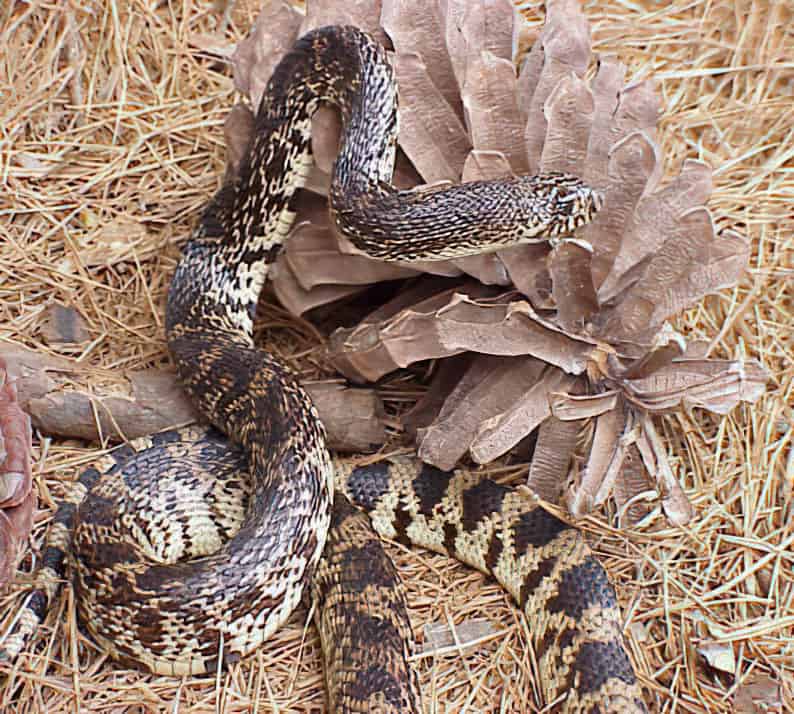
Another endangered snake is the Louisiana pine snake which is endemic to only eastern
Texas
and the western central region of Louisiana.
©Daniel Saenz / public domain – License
Another endangered snake is the Louisiana pine snake which is endemic to only eastern Texas and the western central region of Louisiana. Louisiana pine snakes live in open pine forests with well-drained sandy soil. They rely heavily on Baird’s pocket gophers both as a source of food and as a place to live as they frequently inhabit their burrows. Lousiana pine snakes are large snakes at 48 to 59 inches long and have yellow or tan bodies with large black or brown blotches on them. They are not venomous but often hiss loudly when they are threatened. They also lay the largest eggs and produce the largest hatchlings of any North American snake. Their eggs are five inches by two inches and the hatchlings are between 18 and 22 inches long.
7. Southeastern Crowned Snake (Tantilla coronata)
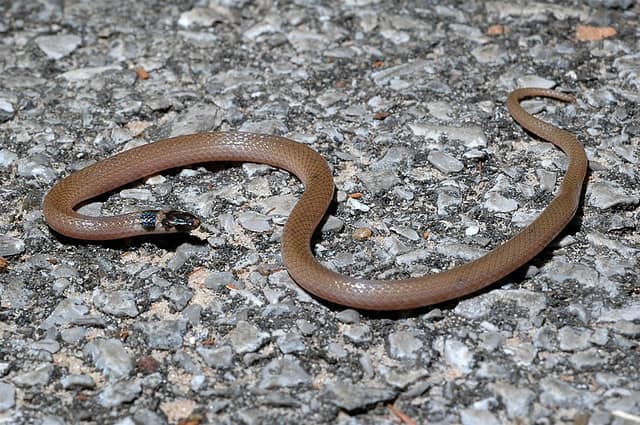
Southeastern crowned snakes are an endangered species in Louisiana and only occur in the Southern Parishes.
© – License
A snake with a particularly distinctive appearance is the southeastern crowned snake which has a light brown body and a black head. They also have a lighter ring of yellow or cream which divides their head and neck. Southeastern crowned snakes are only eight to 10 inches long and are rarely seen due to their secretive nature. They live in flatwoods and pine forests and often burrow into the sandy soil. Southeastern crowned snakes are an endangered species in Louisiana and only occur in the Southern Parishes. They are not venomous and feed only on small animals such as earthworms and insects.
8. Flat-Headed Snake (Tantilla gracilis)
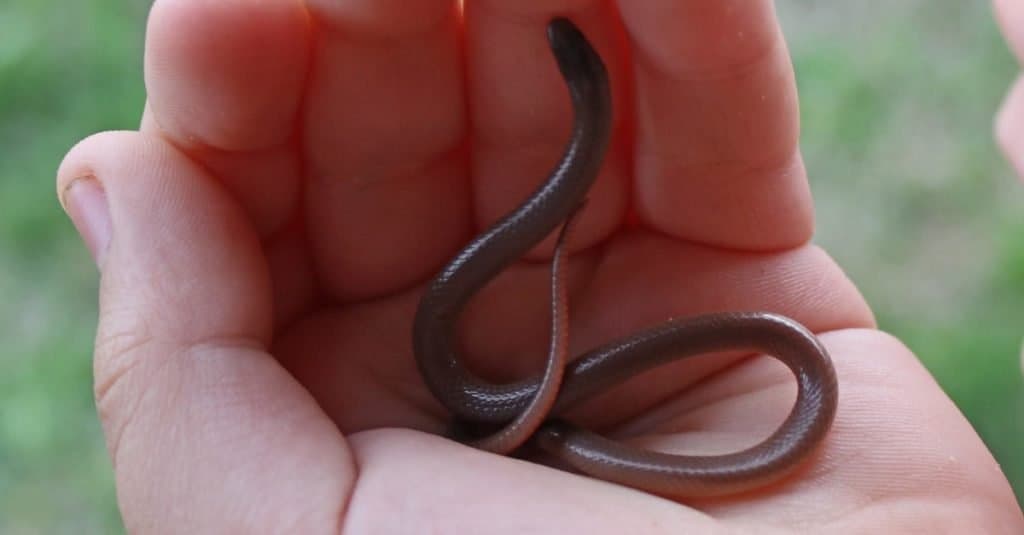
Given their small size, the flat-headed snake pose no threat to humans and prey only on a range of insects and centipedes.
©Creeping Things/Shutterstock.com
Yet another small snake is the flat-headed snake which is only five to nine inches long. Flat-headed snakes are a pale tan color on their upper side and a reddish brown colour on their belly. Their head is also slightly darker than the rest of their body. Flat-headed snakes live in upland pine forests in the northern and central regions of the state. However, they do not occur in the Mississippi River floodplain. Given their small size, they pose no threat to humans and prey only on a range of insects and centipedes.
9. Timber Rattlesnake (Crotalus horridus)
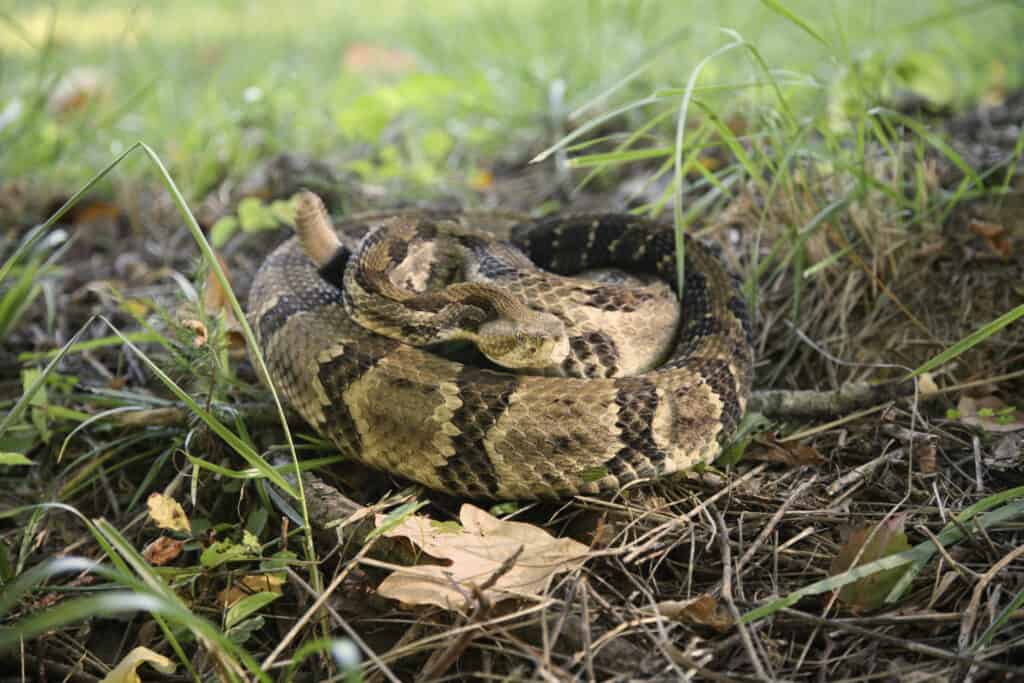
Another venomous brown snake in Louisiana is the
timber rattlesnake
which reaches lengths of between 36 and 60 inches.
©iStock.com/NajaShots
Another venomous brown snake in Louisiana is the timber rattlesnake which reaches lengths of between 36 and 60 inches. They have dark brown bodies which are overlaid with a series of dark brown to black crossband markings. Timber rattlesnakes are regarded as one of the most dangerous snakes in the state due to their high venom yield and long fangs. They occur across the entire state, although they are not as common in the southwest region. They mainly inhabit forests and rocky hillsides, although females can often be found sunning themselves on rocky outcrops that are commonly called “basking knolls”.
10. Prairie Kingsnake (Lampropeltis calligaster)
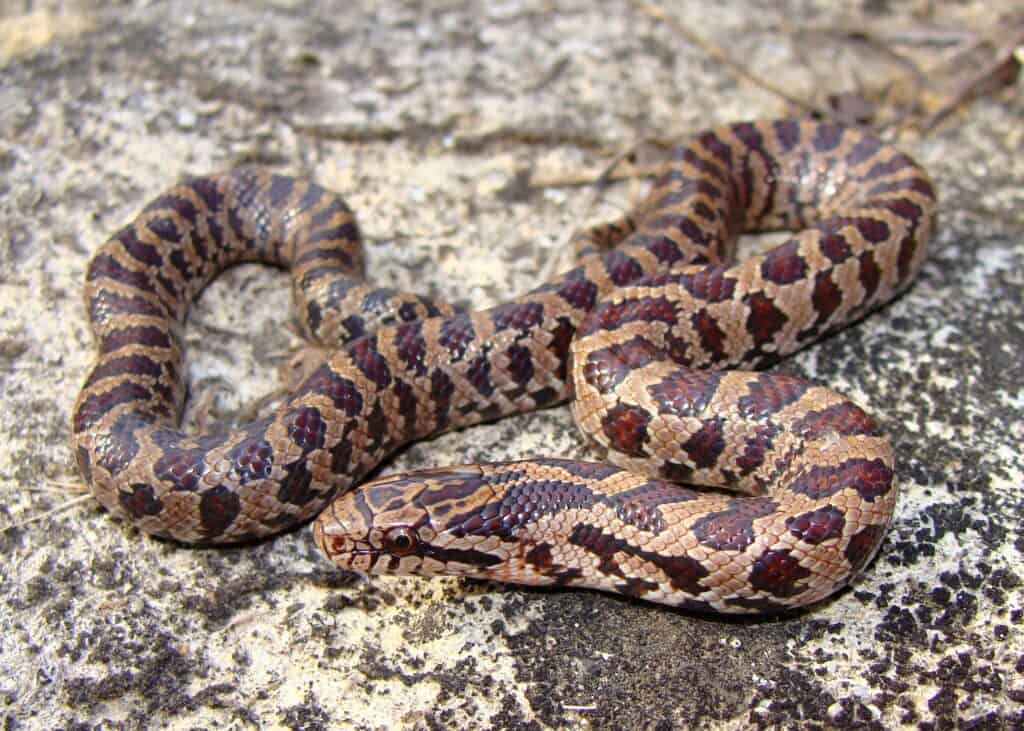
Prairie Kingsnakes are known for their ability to mimic rattlesnakes by vibrating their tail when they are under threat.
©Matt Jeppson/Shutterstock.com
Also known as the yellow-bellied kingsnake, the prairie kingsnake has a light brown body with dark brown blotches. They also have a white or gray belly with darker markings and are 30 to 40 inches long. Prairie kingsnakes live in pine flatwoods and upland forests in the western half of the state. They are not venomous and mainly prey on rodents, lizards, and small snakes. However, they are known for their ability to mimic rattlesnakes by vibrating their tail when they are under threat.
11. Eastern Diamondback Rattlesnake (Crotalus adamanteus)
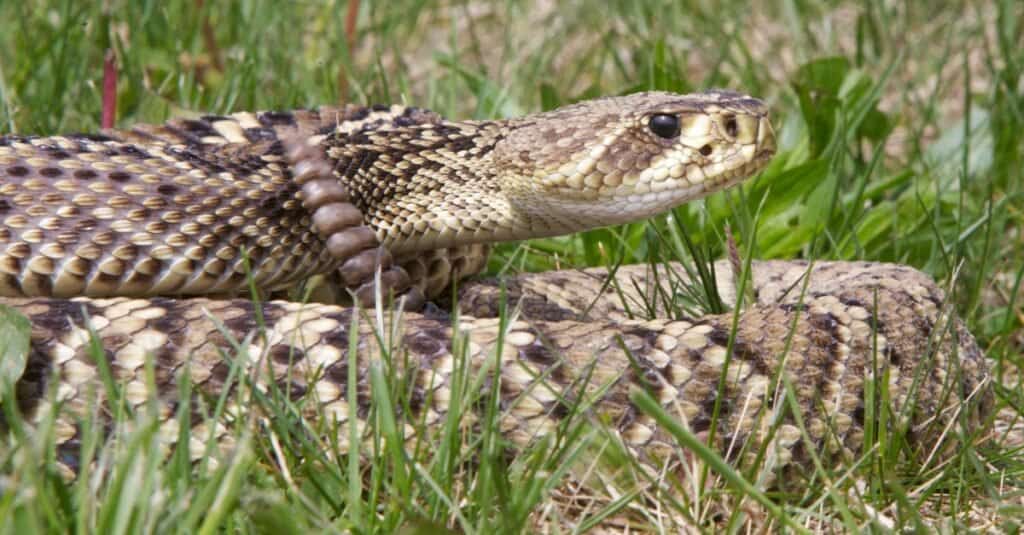
Like the timber rattlesnake, they are highly venomous and are classed as being extremely dangerous.
©iStock.com/NajaShots
Another large, venomous snake is the eastern diamondback rattlesnake which ranges between 25 and 90 inches long. Eastern diamondback rattlesnakes are light to tan brown with darker brown diamond-shaped markings. They are an endangered species within the state and occur only within the eastern parishes of St. Tammany, Tangipahoa, and Washington. They prefer open pinelands and scrubland and prey mainly on rodents. Like the timber rattlesnake, they are highly venomous and are classed as being extremely dangerous.
12. Coachwhip (Masticophis flagellum)
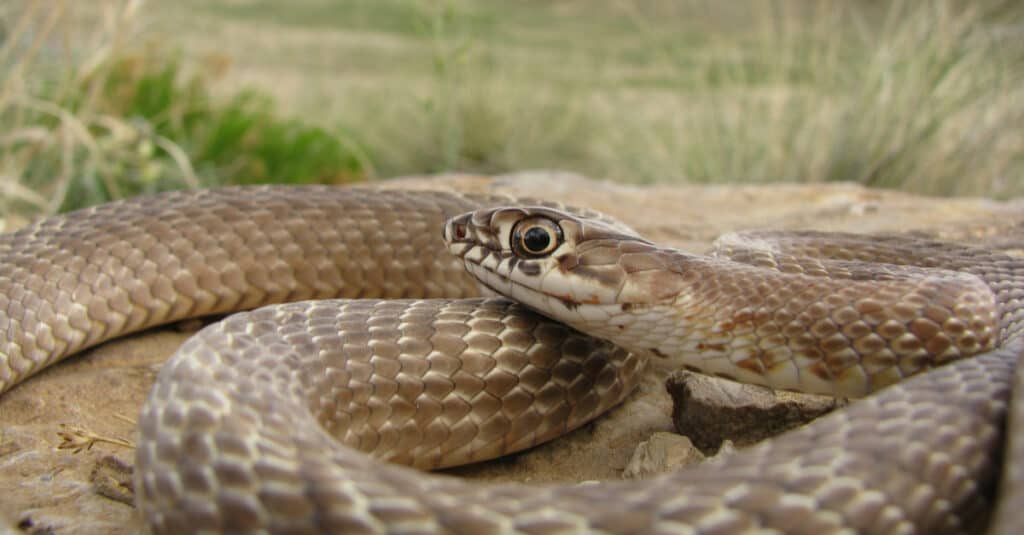
Coachwhips are not venomous but they can be highly aggressive and will readily strike if they are threatened.
©Joe Farah/Shutterstock.com
The final snake we’re going to talk about is the coachwhip which is typically 50 to 72 inches long. Coachwhips have a unique appearance as they are usually a dark brown or black at their head end and gradually lighten to a light tan colour at the tail. They have smooth scales but the pattern of the scales on their tail — along with their colour — gives them the appearance of a braided coachwhip and is the reason they are so named. Coachwhips are not venomous but they can be highly aggressive and will readily strike if they are threatened. They live in pine flatwoods and scrubland but only occur in the Florida Parishes, upland regions on northern and central Louisiana, and in flatwoods to the west of Lake Charles.
Summary of 12 Brown Snakes in Louisiana
| Rank | Species | Unique features | Length |
|---|---|---|---|
| 1 | Diamond-Backed Water Snake (Nerodia rhombifer) | A dark brown chain-like pattern and diamond-shaped markings | 30 to 48 inches |
| 2 | Copperhead (Agkistrodon contortrix) | Dark brown hour-glass shaped markings with lighter-colored centers | 20 to 37 inches |
| 3 | Pine Woods Littersnake (Rhadinaea flavilata) | A reddish-brown color dorsal surface with a lighter-colored belly | 8 to 15 inches |
| 4 | Smooth Earth Snake (Virginia valeriae) | Reddish brown coloring with small black dots on the head | 7 to 10 inches |
| 5 | Dekay’s Brown Snake (Storeria dekayi) | Light brown coloring, a light full-length dorsal edged with black spots on either side | 9 to 13 inches |
| 6 | Louisiana Pine Snake (Pituophis ruthveni) | Yellow or tan coloring covered in large black or brown blotches | 48 to 59 inches |
| 7 | Southeastern Crowned Snake (Tantilla coronata) | Light brown coloring, a light neck ring, and black head patches, | 8 to 10 inches |
| 8 | Flat-Headed Snake (Tantilla gracilis) | A pale tan dorsal surface and a reddish brown ventral surface | 5 to 9 inches |
| 9 | Timber Rattlesnake (Crotalus horridus) | Dark brown coloring and dark brown to black crossband markings | 36 and 60 inches |
| 10 | Prairie Kingsnake (Lampropeltis calligaster) | Light brown coloring, dark brown blotches, and a white or gray ventral surface | 30 to 40 inches |
| 11 | Eastern Diamondback Rattlesnake (Crotalus adamanteus) | Light to tan brown coloring with darker brown diamond-shaped markings | 25 and 90 inches |
| 12 | Coachwhip (Masticophis flagellum) | A dark brown coloring which lightens progressively from head to tail | 50 to 72 inches |
What Is the Most Venomous Brown Snake?
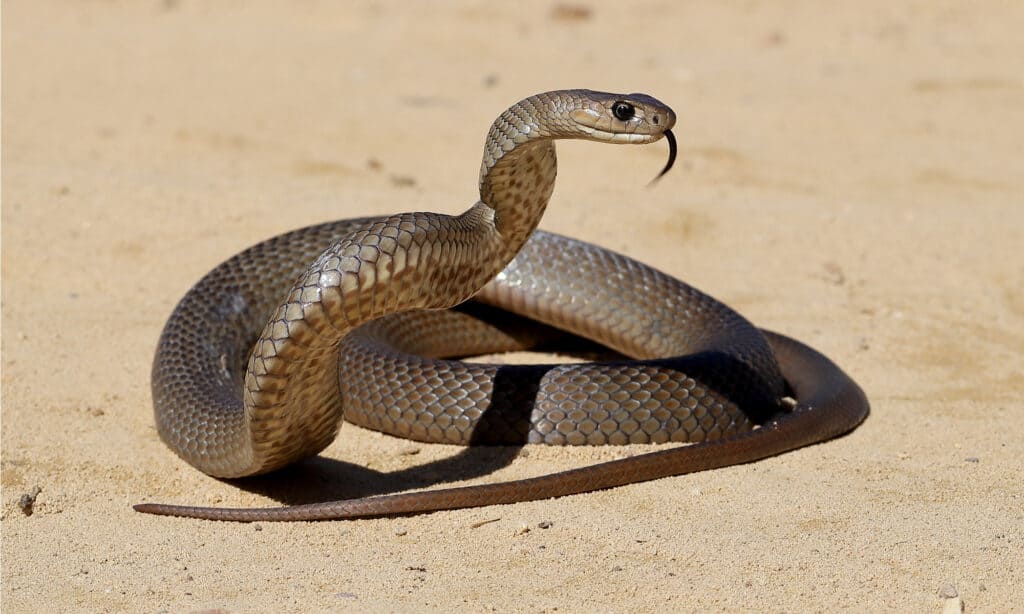
The venomous Eastern Brown Snake, native to Australia and New Guinea, is the second deadliest in the world.
©Ken Griffiths/Shutterstock.com
Residents of Louisiana need not worry too much about the most venomous brown snake in the world–the eastern brown snake (Pseudonaja textilis)–as it is native to Australia and New Guinea. Also referred to as the common brown snake, it is the second deadliest snake in the world, second only to the inland Taipan snake.
Adults have long, slender bodies that reach an average length of 7 feet. Their top scales vary from pale brown to black, with bellies of pale creamy yellow, sometimes with grey or orange splotches. They are found in varied habitats, especially farmland, and even in urban areas.
The venom of an eastern brown snake attacks the circulatory system, causing hemorrhaging, collapse of the cardiovascular system, and cardiac arrest. From 2000 to 2016, 65% of human fatalities in Australia by venomous snake bites were from the eastern brown snake.
The photo featured at the top of this post is © Kristian Bell/Shutterstock.com
Discover the "Monster" Snake 5X Bigger than an Anaconda
Every day A-Z Animals sends out some of the most incredible facts in the world from our free newsletter. Want to discover the 10 most beautiful snakes in the world, a "snake island" where you're never more than 3 feet from danger, or a "monster" snake 5X larger than an anaconda? Then sign up right now and you'll start receiving our daily newsletter absolutely free.
Thank you for reading! Have some feedback for us? Contact the AZ Animals editorial team.






